In this article, we will learn about cells, their components and their composition. We will also learn about the structural organisation of cells and the types of cells. After reading this article, readers will be able to tell the following:
What is cell?
What is the cell made up of?
What is the structural organisation of the cell?
Types of cell.
Key Components and Organisation Levels Within a Cell Explained
A cell is the most fundamental structural and functional unit of all living things. A cell is a structure with organelles that perform the essential tasks it needs to survive. But not every cell is the same. Animal cells are very different from plant cells. One of their main distinctions is the absence of cell walls in animal cells.
Additionally, different cells have different sizes; the egg or female ovum is the biggest cell in the human body. It is around 1 millimetre across. Granule cells are the tiniest cells, about 4.5 micrometres in size, and are found in the human cerebellum.
Types of Cells
Eukaryotic and prokaryotic cells make up the majority of cells.
Prokaryotic Cell
The prokaryotic cell's primary characteristics are listed below.
Bacteria, mycoplasma, and blue-green algae represent them.
Different shapes multiply quickly.
It is the naked genetic material.
Organelles in cells are missing.
Except in Mycoplasma, the presence of a cell wall around the cell membrane.
The two components, the 50s and 30s of ribosomes, which are joined to form the 70s ribosomes and serve as locations for protein synthesis, are connected to the cell membrane.
Polyribosomes are ribosomes that chain together with RNA.
The cytoplasm contains reserved elements such as cell inclusion bodies.
The Eukaryotic Cell
The following lists the primary characteristics of eukaryotic cells.
Animals, plants, fungi, and protists all have eukaryotic cells.
Organelles bound to membranes cause the cytoplasm to be separated into compartments.
A well-organised nucleus enclosed by a nuclear membrane is present.
Chromosomes are structures that hold genetic material.
In addition to the membrane, plant cells also have a cell wall. In contrast to animal cells, they have a sizable central vacuole.
Animal cells have centrioles, which are distinctive.
The Structural Organisation of a Cell
We will now discuss the structural organisation of a cell in detail.
Cell Membrane
One crucial component of the cell is the cell membrane.
Composed of phosphoglyceride-containing lipids organised in a bilayer. Later, protein compounds were also found.
Proteins exist in two forms: integral protein, which is submerged in the membrane, and peripheral protein, which is exposed.
According to Singer and Nicholson's hypothesis, the membrane's quasi-fluid structure makes it possible for proteins to migrate across the bilipid layer.
The plasma membrane's main job is to guarantee that chemicals are transported.
Cell Wall
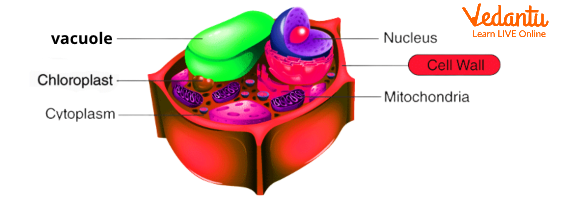
Cell Wall
The following is a list of the cell wall's properties.
It is composed of algae and plants.
Plants use cellulose, hemicellulose, and pectin to make their cell walls.
Galectins, minerals, and cellulose make up the algal cell wall.
Plants' main cell walls can't expand, therefore, once they reach maturity, they quickly change into secondary cell walls.
The endoplasmic reticulum, Golgi bodies, lysosomes, and vacuoles comprise the endomembrane system.
Endoplasmic Reticulum
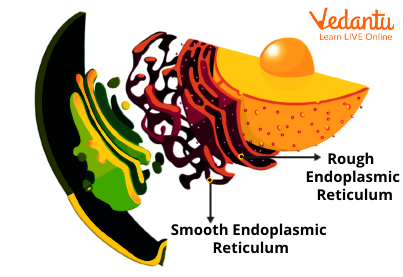
Endoplasmic Reticulum
The endoplasmic reticulum is involved in some of the most crucial processes.
Ribosomes are not present on the surface of smooth ERs, which are involved in lipid production.
Rough ER: Produces and secretes proteins and has ribosomes on its surface.
Golgi Apparatus
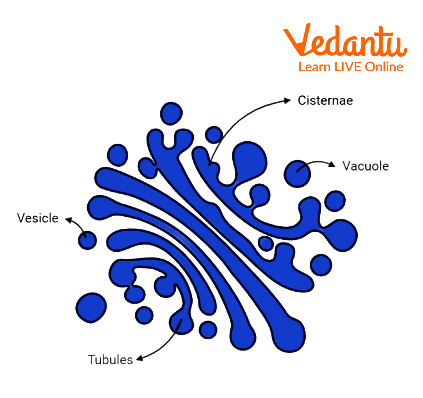
Golgi Apparatus
The Golgi apparatus is a further crucial component of the cell.
It is a site of glycoprotein and glycolipid production.
Golgi Apparatus is involved in transporting and packaging materials.
Golgi Apparatus consists of parallel stacks of flat, disc-shaped cisterns.
Lysosome
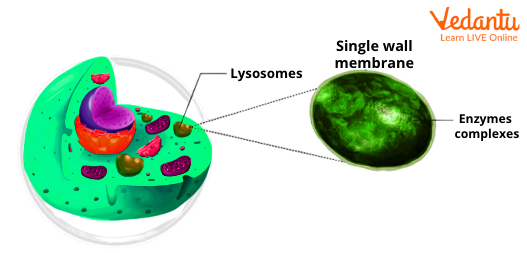
Lysosome
The membrane-bound structure. It has an abundance of hydrolytic enzymes like lipase and protease that can break down proteins, carbs, and lipids.
Mitochondria
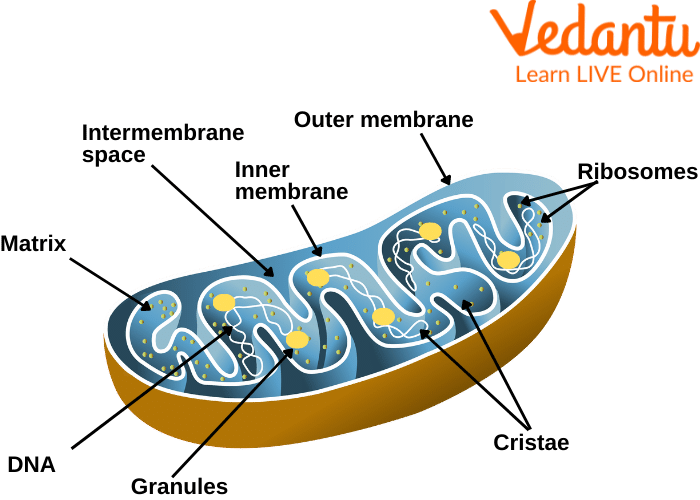
Mitochondria
The mitochondria are the next critical component of the cell structure. These characteristics are listed below.
Mitochondria are found in areas where aerobic respiration occurs.
Mitochondria produce ATP, which is the cellular energy currency.
The matrix comprises ribosomes, circular DNA molecules, RNA molecules, and protein synthesis-related molecules.
Plastids
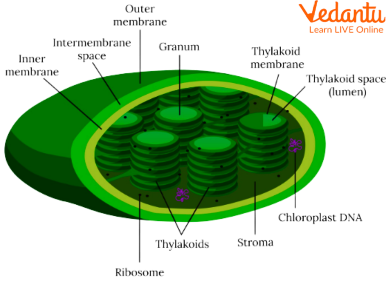
Plastids
Another crucial component of the cell structure is the plastids.
Plastids are available in plant cells.
Plastids are organelles with a limited degree of autonomy and different genetic makeup.
Depending on the type of pigment discovered, there are three types. As follows:
Leucoplasts are nutrient-stored, colourless plastids of various shapes.
Chromoplasts: Because soluble lipids are present, they have a yellowish or reddish colour.
Double membranous structures are called chloroplasts. The term "stroma" refers to the inner membrane. The stroma contains stacks of thylakoids called grana. Enzymes for protein synthesis are present in the stroma.
Centrosome
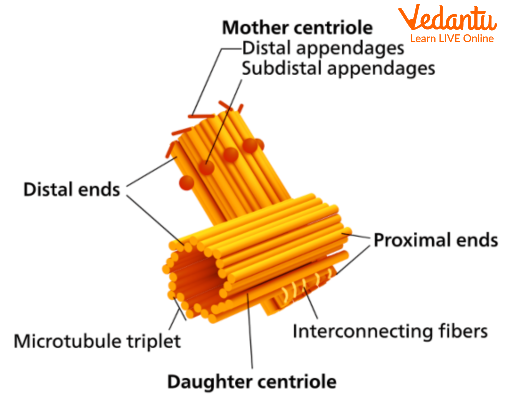
Centrosome
This is a crucial component of the cell structure.
The centrosome consists of two centrioles, which are cylindrical structures.
The spokes are the peripheral fibrils in the hub of the centriole.
Nucleus
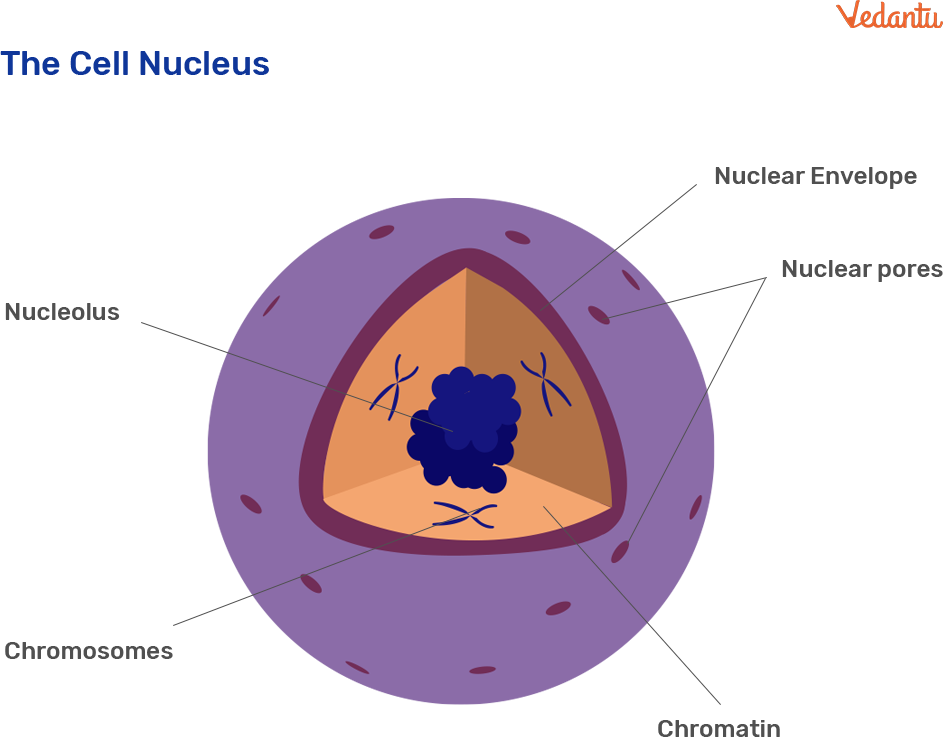
Nucleus
The nucleus is located further along in a cell's structure. It carries out several significant tasks.
It has chromatin, nuclear matrix, and nucleoli, which are extremely extended nucleoprotein fibres.
During cell division, chromatin material rearranges into chromosomes.
It consists of proteins and histones.
The centromere, or major constriction, is found at the centre of each chromosome on its disc.
Chromosomes can be classified as metacentric, submetacentric, telocentric, or acrocentric, depending on where the centromere is located.
Interesting Facts
The nerve cell are the only cell in the human body that will remain the same in number as they were at birth
Telomeres present at the end of each chromosome decide the life span of the cell.
All animal cells are self-sufficient, they have their own factory or machinery for the generation of essential components of the cell.
Every human cell divides in 24 hours.
Important Questions
1. How are cells formed?
Mitosis or meiosis is the process by which one cell divides to form other cells; during these divisions, the whole content of a cell duplicates and divides into two daughter cells.
2. Do all cells contain DNA?
Yes, all cells contain DNA as genetic material. All cells contain the full set of DNA required for that organism.
3. What is the structure of a cell?
There are three main parts of a cell, nucleus, cell membrane, and cytoplasm; other than this, many organelles are also present in the cytoplasm.
Practice Question
1. What is the structural organisation of a cell?
2. What is a cell made of?
3. Who discovered the cell?
4. What are the various functions of a cell?
Key Features
Cells are the fundamental biological, structural, and functional elements of all living organisms. A cell has the ability to reproduce on its own. They are, therefore, referred to as the basis of life.
The cell organelles are the cellular constituents. These membrane-bound cell organelles are located inside cells and have unique shapes and roles.
For the cell to function normally, they effectively coordinate with one another. A few of them give the cell structure and support, while others play a role in the cell's movement and reproduction.


FAQs on What Is a Cell Made Of and How Is It Structurally Organised?
1. What is a cell made up of, and what is its basic structural organisation?
A cell is the fundamental structural and functional unit of all living organisms. Its basic structural organisation consists of three essential components: the plasma membrane (the outer boundary), the nucleus (which contains the genetic material), and the cytoplasm (the jelly-like substance filling the cell, where various organelles are suspended). This organisation ensures the cell can perform all its life-sustaining functions.
2. What are the key differences in the structure of a plant cell versus an animal cell?
The primary structural differences between plant and animal cells are:
- Cell Wall: Plant cells have a rigid cell wall made of cellulose outside the plasma membrane, providing structural support. Animal cells lack a cell wall.
- Vacuoles: Plant cells typically have a single, large central vacuole that maintains turgor pressure. Animal cells may have several small, temporary vacuoles.
- Plastids: Plant cells contain plastids, such as chloroplasts for photosynthesis. Animal cells do not have plastids.
- Centrosomes: Animal cells have centrosomes, which play a role in cell division, whereas this structure is absent in most higher plant cells.
3. Why is the plasma membrane called a 'selectively permeable membrane'?
The plasma membrane is called a selectively permeable membrane because it regulates the movement of substances into and out of the cell. It allows certain essential molecules, like oxygen and water, to pass through easily while blocking others. This selective nature is crucial for maintaining the cell's internal environment, a process known as homeostasis, and protecting it from harmful substances.
4. What is the importance of the nucleus in a cell?
The nucleus is often called the 'control centre' or 'brain' of the cell for two main reasons:
- It contains the cell's genetic material, DNA (Deoxyribonucleic acid), organised into structures called chromosomes. This DNA holds the instructions for building and operating the entire cell.
- It controls all metabolic activities of the cell and plays a central role in cell division, growth, and reproduction.
5. How do the Endoplasmic Reticulum and Golgi apparatus work together as part of the cell's manufacturing and transport system?
The Endoplasmic Reticulum (ER) and the Golgi apparatus form a coordinated production line. The ER, particularly the Rough ER, synthesises proteins and lipids. These molecules are then packaged into vesicles and transported to the Golgi apparatus. The Golgi modifies, sorts, and packages these proteins and lipids into new vesicles, which are then dispatched to their final destinations, either inside or outside the cell. This collaboration is vital for secretion, membrane repair, and delivering enzymes to organelles like lysosomes.
6. If mitochondria are the 'powerhouses of the cell', what happens if they stop working?
If a cell's mitochondria stopped working, the cell would be unable to perform cellular respiration effectively. This means it could not produce ATP (Adenosine Triphosphate), the main energy currency for most cellular activities. Without ATP, vital functions like muscle contraction, nerve impulse transmission, and the synthesis of new molecules would cease, quickly leading to cell death.
7. Why are lysosomes known as the 'suicide bags' of the cell, and what is their primary function?
Lysosomes contain powerful digestive enzymes capable of breaking down waste materials, foreign invaders like bacteria, and worn-out cell organelles. They are called 'suicide bags' because if the cell is severely damaged or old, the lysosomes can burst and release these enzymes, which then digest the entire cell. However, their primary day-to-day function is to act as the cell's waste disposal and recycling system, keeping it clean and functional.
8. What is the main difference between prokaryotic and eukaryotic cells?
The most significant difference is the presence of a true nucleus. Eukaryotic cells (found in plants, animals, fungi) have a well-defined nucleus enclosed by a nuclear membrane, which contains their genetic material. Prokaryotic cells (found in bacteria) lack a true nucleus; their genetic material is located in a region of the cytoplasm called the nucleoid. Additionally, eukaryotic cells have complex, membrane-bound organelles like mitochondria and ER, which are absent in prokaryotic cells.
In this article, we will learn about cells, their components and their composition. We will also learn about the structural organisation of cells and the types of cells. After reading this article, readers will be able to tell the following:
What is cell?
What is the cell made up of?
What is the structural organisation of the cell?
Types of cell.










